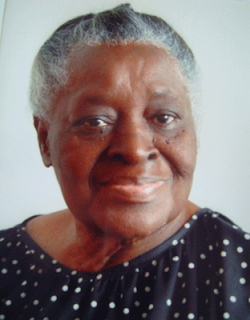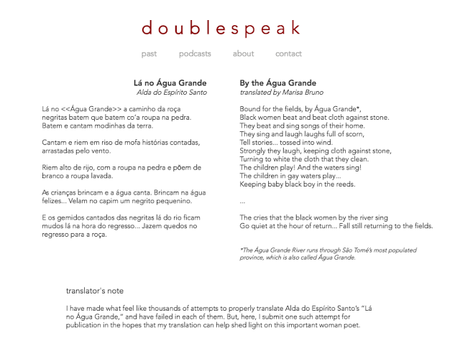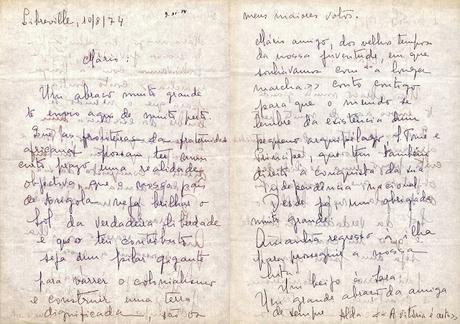
Image Source: Templo Cultural Delfos
Wisner goes on to explain that while Alda's work is included in a number of anthologies, such as Stella and Frank Chipasula's 1995 edited volume The Heinemann Book of African Women’s Poetry:her life is so little known that she appears in three of them [anthologies] with a misspelled name (Aldo rather than Alda) that transforms her into a man.Of her verses, however, the Chipasula's note that they 'were once considered subversive and dangerous by the Portuguese colonial authorities.' This relegation of Alda do Espírito Santo’s work (like that of most Lusophone African writers, and especially women writers), to the periphery of African literature seems to be a recurring theme in my research. This in itself is a separate post, and there are many scholars who have written on it, but here's an interesting piece on Lusophone African Women's Writing. Of note, however, is how very influentialAlda do Espírito Santo's work and poetry was. Indeed on Alda do Espírito Santo and her poems,Marisa Bruno who translated one for Double Speak magazine, writes:
... as both writer and government leader, [Alda] played an essential role in São Tomé and Príncipe’s transition to independence from Portugal. She writes as a woman, to women and for women, presenting her readers with images of strong women who have the power to liberate the islands from Portuguese colonial oppression. Despite her privileged upbringing, she dedicates her words to the working class women of the islands who carried, both figuratively and literally, the future of the islands on their backs. The women she describes in poems like “By the Água Grande” are mothers, workers, and, most importantly, fighters.
English translation of one of Alda's poems
Alda do Espirito Santo was born April 30 1926 to a prominent Creole family - primary education in São Tomé, secondary school in Porto, and training as a primary school teacher in Lisbon from 1948. It was in Lisbon that she joined an association of students from Portuguese colonies known as Casa dos Estudantes. There she published one of her first pieces, a feminist article, in 1949. It was also at Casa that she came in contact with future nationalist leaders of Angola, Cape Verde, Guinea-Bissau and Mozambique, and where her poetry was published in the collection Caderno: A Collection of Poetry by Portuguese Speaking Black African Writers.A write-up of Alda do Espírito Santo on the Afrotourism website further reveals her fascinating life story:
Alda returned to São Tomé in January 1953, and started work as a primary school teacher. That same year, she assisted Palma Carlos, a Portuguese lawyer who was in São Tomé to investigate the atrocities committed by the colonial authorities during the Sao Tome massacre, in February barely a month after her return to the country.In 1951, together with Mário Pinto de Andrade, Amilcar Cabral, Marcelino dos Santos, Agostinho Neto and other African students inspired by nationalism, Alda Neves da Graça do Espírito Santo founded the cultural association, Centro de Estudos Africanos.Along with the lawyer, they collected testimonials from survivors of the massacres. Her most famous poem: Onde Estão os Homens Caçados Neste Vento de Loucura was written about the February 1953 massacre. Titled Where are the men chased by that mad wind?, and translated from Mario de Andrades French version by Jacques-Noël Gouat, the poem was included in The Heinemann Book of African Women's Poetry, and here's an excerpt via the Woyingi blog:
Ze Mulatto in the annals of the wharf
Executing men
Amidst the thump of falling bodies.
Ah! Ze Mullato, Ze Mullato
Your victims cry out for revenge.
And the sea, the sea of Fernao Dias
That has swallowed up those human lives
The sea is red with blood.
Of course, there is more to Alda do Espírito Santo's life as indicated in the article on the Afrotourism website. This includes being detained or two and half month with sixteen other São Tomé indigenes on accusation of intent to create a subversive movement on the archipelago - this was in Lisbon in December 1965; becoming one of the leaders of Associação Civica pró-MLSTP after the Portuguese revolution of April 25, 1974 - they organised political actions; and on September 19, 1974 leading a group of women clad in black in a demonstration in front of the governor’s palace against the alleged poisoning of salt and drinking water by the Portuguese - after Independence, September 19 was declared National Women’s Day.
Letter written to Mário Pinto de Andrade in August 1984
Alda do Espírito Santo’s excellent credentials also include being a member of the Political Bureau of the Movement for the Liberation of São Tomé and Príncipe, part of the transitional government that led São Tomé and Príncipe to independence, a former Minister of Culture and Education, Social Affairs and Culture Minister, the first woman to become Deputy Head of State and the founder of the National Union of Writers and Artists of Sao Tome– another badass woman in this series. Alda also wrote the lyrics of Sao Tome and Principe’s national anthem, Independência Total:
Working, struggling, struggling and conquering,Alda do Espírito Santo passed away in 2010, at the age of 83 in Luanda - and the government declared 5 days of national mourning in her honor.
We go ahead with giant steps
In the crusade of the African people
Raising the national flag.



